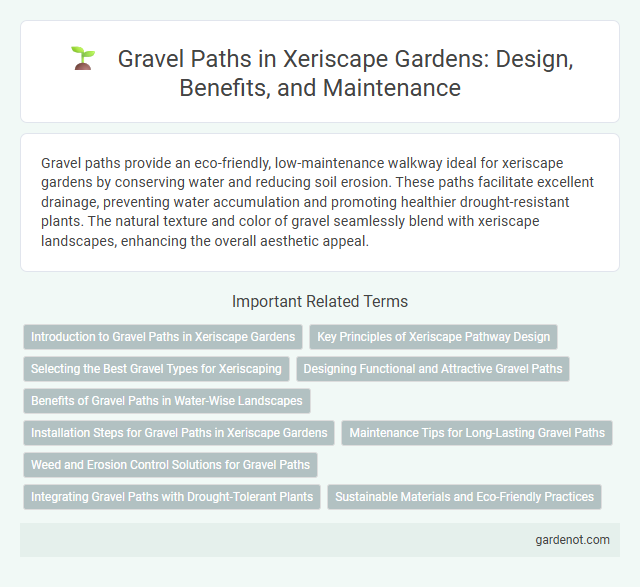Gravel paths provide an eco-friendly, low-maintenance walkway ideal for xeriscape gardens by conserving water and reducing soil erosion. These paths facilitate excellent drainage, preventing water accumulation and promoting healthier drought-resistant plants. The natural texture and color of gravel seamlessly blend with xeriscape landscapes, enhancing the overall aesthetic appeal.
Introduction to Gravel Paths in Xeriscape Gardens
Gravel paths in xeriscape gardens offer efficient water conservation and low-maintenance landscape solutions by reducing soil erosion and allowing better drainage. These permeable walkways enhance garden aesthetics with natural textures while supporting drought-tolerant plantings. Utilizing locally sourced gravel further minimizes environmental impact and complements xeriscaping principles.
Key Principles of Xeriscape Pathway Design
Gravel paths in xeriscape design emphasize water conservation by reducing impervious surfaces and promoting natural infiltration. Selecting permeable substrates like small, angular gravel enhances drainage while minimizing runoff and erosion. Incorporating native plants along the pathway edges stabilizes soil, supports local biodiversity, and reinforces drought-resistant landscaping principles.
Selecting the Best Gravel Types for Xeriscaping
Selecting the best gravel types for xeriscaping involves choosing materials that maximize water efficiency and durability while enhancing landscape aesthetics. Pea gravel, decomposed granite, and crushed stone are popular options due to their excellent drainage properties and ability to prevent soil erosion. Proper gravel selection reduces water runoff and compaction, supporting sustainable drought-resistant gardening practices.
Designing Functional and Attractive Gravel Paths
Gravel paths offer a sustainable and low-maintenance solution for xeriscape gardens, providing excellent drainage and weed resistance. Designing functional and attractive gravel paths involves selecting appropriate gravel sizes, such as pea gravel or crushed stone, to ensure stability and comfort underfoot. Incorporating edging materials like metal or stone helps maintain clean lines and prevents gravel displacement, enhancing both the aesthetic appeal and durability of the pathway.
Benefits of Gravel Paths in Water-Wise Landscapes
Gravel paths enhance water-wise landscapes by promoting efficient water drainage and reducing runoff, helping to conserve soil moisture and prevent erosion. Their permeable surface allows rainwater to infiltrate the ground, supporting sustainable water management in xeriscaping. Gravel paths also require minimal maintenance and do not demand irrigation, making them ideal for drought-tolerant garden designs.
Installation Steps for Gravel Paths in Xeriscape Gardens
Laying a gravel path in xeriscape gardens begins with marking the desired path shape and excavating the area to a depth of 4 to 6 inches. Next, install a weed barrier fabric to prevent unwanted growth and ensure proper drainage, followed by placing a compacted base layer of crushed stone for stability. Finally, spread a 2 to 3-inch layer of decorative gravel evenly, smoothing it out and edging the path to maintain clean borders.
Maintenance Tips for Long-Lasting Gravel Paths
Regularly raking and removing debris from gravel paths prevents weed growth and maintains a smooth surface, enhancing durability. Applying a weed barrier fabric beneath the gravel significantly reduces weed intrusion and erosion over time. Periodically replenishing gravel ensures proper drainage and restores the path's appearance, extending its lifespan in xeriscape designs.
Weed and Erosion Control Solutions for Gravel Paths
Gravel paths benefit from effective weed and erosion control solutions such as geotextile fabric liners that prevent weed growth while allowing water permeability. Incorporating edge restraints like metal or stone borders helps maintain gravel placement and reduces soil displacement during heavy rain or foot traffic. Regular application of mulch or polymeric sand between gravel pieces further stabilizes the surface and minimizes weed infiltration.
Integrating Gravel Paths with Drought-Tolerant Plants
Gravel paths seamlessly complement xeriscape gardens by enhancing water conservation efforts while providing natural drainage. Integrating drought-tolerant plants such as lavender, sedum, and ornamental grasses along gravel walkways creates a harmonious, low-maintenance landscape that thrives in arid conditions. This combination reduces irrigation needs and prevents soil erosion, promoting a sustainable, eco-friendly garden design.
Sustainable Materials and Eco-Friendly Practices
Gravel paths utilize sustainable materials by incorporating locally sourced, permeable aggregates that reduce stormwater runoff and promote natural groundwater recharge. Eco-friendly practices in xeriscape design focus on minimal soil disturbance and the use of recycled or low-impact gravel, lowering carbon footprints and supporting habitat preservation. These methods optimize water conservation while maintaining durability and aesthetic appeal in drought-tolerant landscapes.
Gravel path Infographic

 gardenot.com
gardenot.com